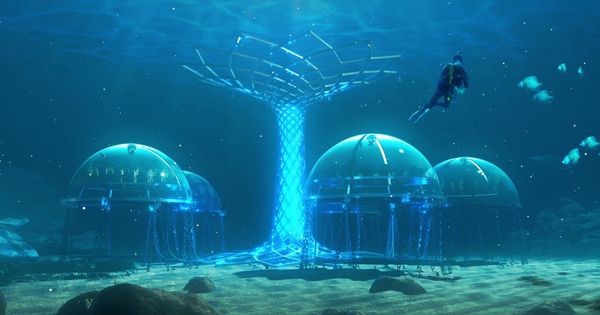Hydroelectric dam cornered
Snow has been falling heavily for days in the Indian Himalayas. Then, on the morning of February 7, 2021, part of Mount Ronti cracked and collapsed. The avalanche had enough rock and ice to fill 12,000 Olympic swimming pools and was traveling at a speed of 193 km/h down to the foothills of the Ronti Gad River valley.
Friction melted the ice and created a cataclysm that raged on the river’s flow, devastated two hydroelectric plants and killed more than 200 workers and residents.
This incident is not a surprise. Since the massive dam was announced two decades ago, scientists have warned that the valley is a dangerous site because of its susceptibility to earthquakes and avalanches.
India’s largest electricity producer NTPC Ltd. conducted the Tapovan Vishnugad project. In 2013, this project along with more than 30 other dams in the area were damaged by flash floods and lake ice overflow. Then there was the landslide in 2021 mentioned above.
NTPC was undeterred when the project, before it could generate electricity, suffered two natural disasters in less than a decade. Construction workers are still busy clearing debris and repairing the cracked structure.
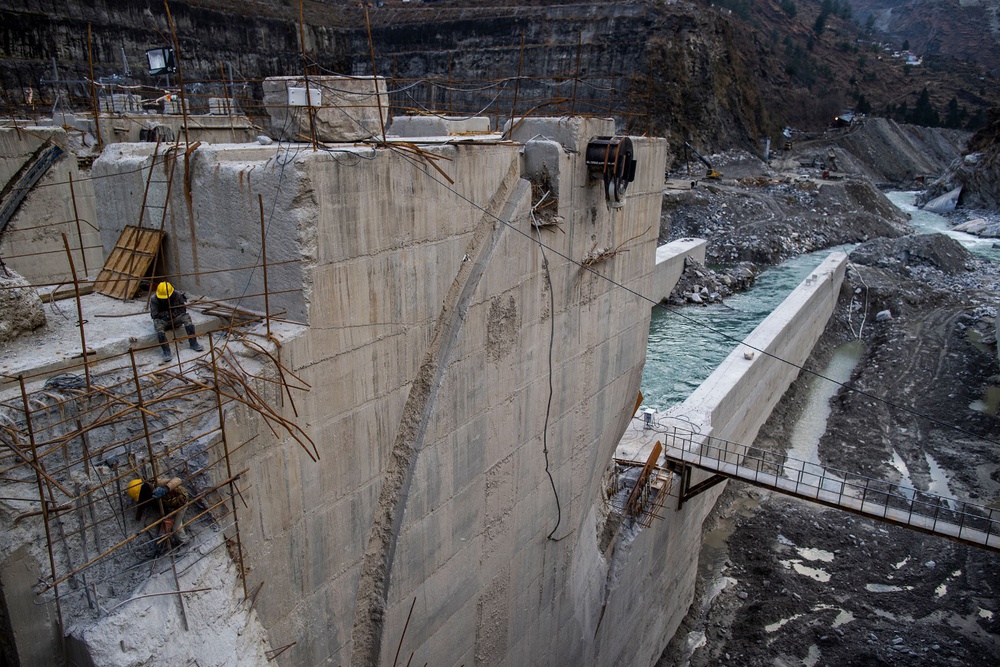
Workers repair the Tapovan Vishnugad hydroelectric power plant, Bloomberg photo
Many locals think that their life would be better without hydropower. Bhawan Rana is the head of Raini village, where people can see one of the dams being washed away. The village chief said: “Whenever it rains, we fear for our lives. Careless construction has shaken the foundations of our houses.”
Power generation from hydroelectricity is critical to controlling global warming. The International Energy Agency (IEA) is calling for a doubling of hydroelectricity by 2050. This is seen as a step towards net zero emissions. But the $1 trillion cost in the global expansion plan will only which adds about 500 GW, or 38% of the current capacity.
Since 1982, when the first hydroelectric plant came online on the Fox River in Wisconsin, ancillary systems have focused on economically viable spots where flows are fast enough to turn turbines.
But 140 years later, the most favorable places in the developed world have been exploited. Builders started moving to more dangerous areas like the Himalayas or deep in reserves like the Amazon.
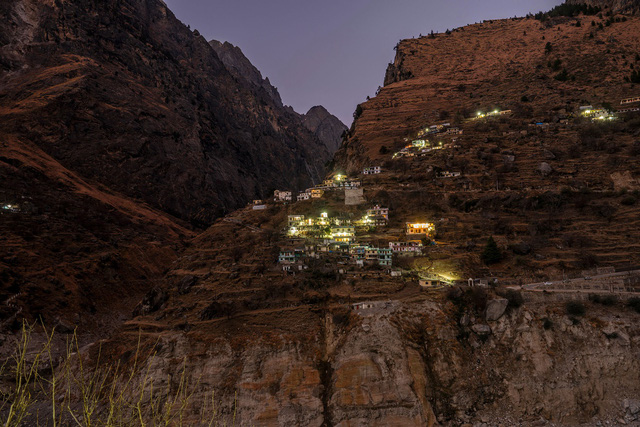
Rainy Village. Photo: Bloomberg
Building on outdated data
The majority of new projects are located in developing countries. These projects are frequently delayed, underfunded, or placed in dangerous locations. They are more at risk from the effects of climate change, thereby limiting their potential to help prevent future warming.
According to the scientists, the new dams were created without using climate models or relying on old data. Outdated numbers either overestimate rainfall or underestimate the potential risk from flooding and landslides. This raises questions about the financial viability of the new site. Workers and local people also face risks.
Homero Paltán, a water and climate researcher at the World Bank and the University of Oxford, said: “Hydroelectric projects are often planned according to past climates, which may no longer be relevant. This is not discussed thoroughly and it has consequences for the global energy market.”
Upstream of Tapovan, the Rishiganga small hydroelectric project was the first to be flattened in February 2021. Apart from natural disasters, reduced water flow due to receding glaciers is a big problem for the industry in India.
The 400 MW Vishnuprayag project, downstream of Tapovan, is one of the first in the region. But maintaining operations is extremely difficult when the project is constantly closed for maintenance due to floods and landslides.
However, it is the drought that is a much bigger concern than the floods. According to Paltán, about 80% of existing and planned hydropower projects in developing countries are located in areas where droughts are expected to last more than 10%.
For example, Brazil’s Belo Monte hydroelectric dam failed to produce 11.2 GW of capacity. Even if all 24 turbines are operational for the first time in 2021, the average output will only come to 3.6 GW due to drought.
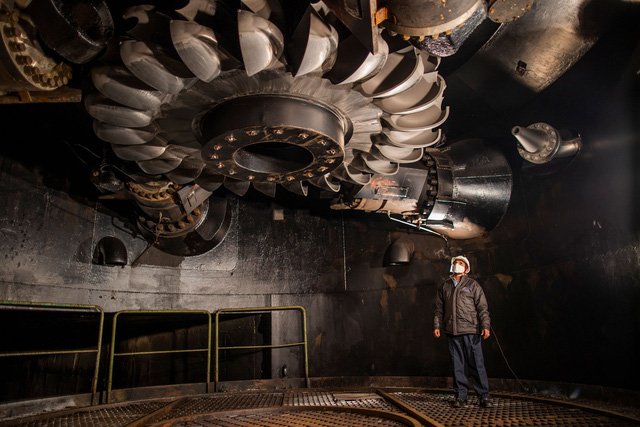
An engineer checks turbines at the Vishnuprayag hydroelectric power station. Photo: Bloomberg
The backbone of renewable energy is not ready for the 21st century
The combination of global warming and deforestation is weakening the economics of the project. The Brazilian Amazon has lost an area the size of the US state of Connecticut by 2021.
The boom in wind parks or solar farms has not dampened the need for hydroelectricity. The erratic use of renewables only increases reliance on renewable or convertible energy such as hydro or nuclear.
Take India, for example, which plans to quadruple renewable energy, but will need more hydro, nuclear and batteries to avoid relying on coal and gas as a reserve energy source.
According to the IEA, solar is poised to grow 20-fold by 2050, followed by an 11-fold increase in wind. While industrial batteries and green hydrogen may play a balancing role, if hydrogen does not double in size, the world could still depend on fossil fuels to support the grid. Nuclear power is also poised to double by 2050, but that won’t be enough to make up for the shortage of river turbines.
The Tibetan Plateau is where the threat to hydropower is most clearly seen. It is often called the “water tower of Asia” because it contains the most ice outside the polar regions. The rate of melting has doubled in the past 20 years, and two-thirds of glaciers could disappear by the end of the 21st century.
China, India, Nepal and Pakistan are rushing to exploit as much hydroelectricity as possible because global warming is bringing more risks. China has plans to build the country’s largest super dam in a valley five times deeper than the Grand Canyon.
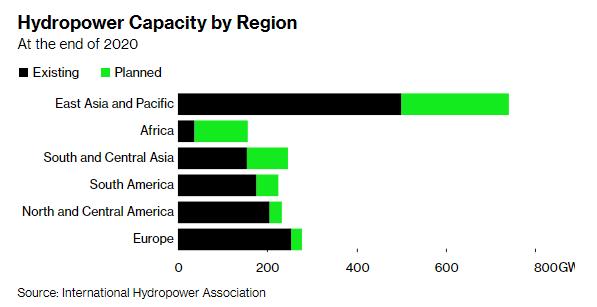
Hydroelectric capacity in the regions. Source: International Hydropower Association.
Wolfgang Schwanghart, a natural geographer at the University of Potsdam in Germany, says the good sites have been exploited. Large projects are increasingly receding into more dangerous areas.
In a study he published in 2016, Schwanghart mapped 2,359 glacial lakes in the Himalayas and found that 56 hydroelectric projects located near the lake were at risk of damage in the event of a lake overflow.
A total of about 90% of hydroelectric dams have been built in East Asia and 50% are at risk of being threatened by river flows and recurrent floods. But less than 20% of the potential 500 GW in the Himalayas has been tapped. A study published in Nature Energy in 2017 found that 39% of hydropower potential lies in the Asia-Pacific, 25% in South America and 24% in Africa.
Population growth and rising temperatures make farmers more dependent on irrigation systems. Cities and expanding industries also need fresh water. Dams can even create geopolitical tensions.
All of the above shows that hydropower, the backbone of renewable energy historically, is not ready to meet the needs of the 21st century. Older hydroelectric plants need to be upgraded and their public costs reduced. turmeric.
According to Bloomberg
at Blogtuan.info – Source: Soha.vn – Read the original article here



